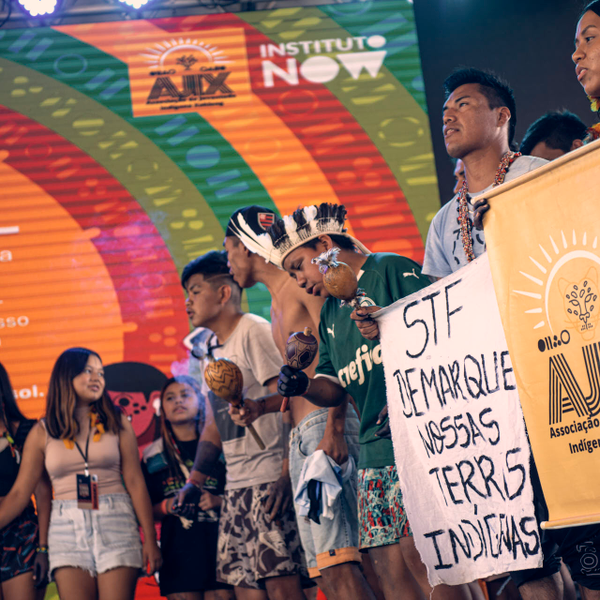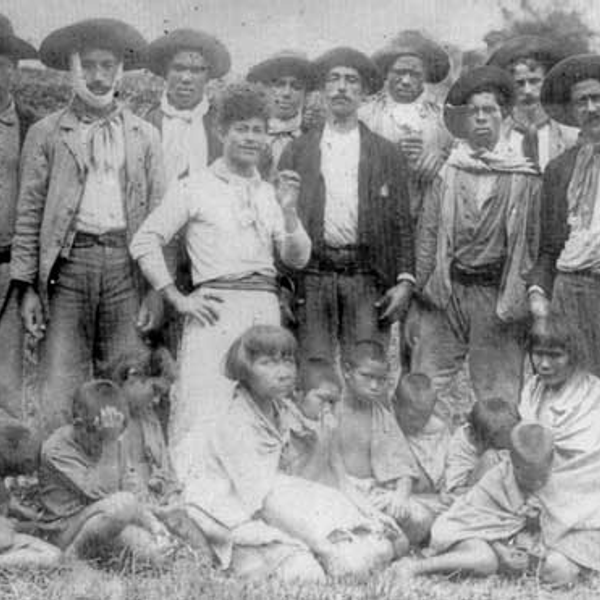O som Intangível do Contato
room 20 ECHOES
Location: Blumenau, Santa Catarina, Brazil
@intangiblesoundof_contact
(SCROLL DOWN FOR ENGLISH)
Caminhe pelo centro histórico e ouça uma parte pouco conhecida da história de Blumenau. Recomenda-se o uso de fones de ouvido.
Nesta caminhada você vai ficar sabendo o que acontecia em Blumenau no início do século XX. Neste momento, o assunto que gerava as mais acaloradas discussões na imprensa Blumenauense era o contato entre colonos alemães e os indígenas da região. A caminhada abre a palavra para o povo Laklãnõ-Xokleng. Os autores Laklãnõ-Xokleng João Voia, Samara Vatxun Camlen e Koziklã Sanara Criri Rodrigues nos contam o que seus avós e parentes sempre contaram. Laura Mello recolheu informações de trabalhos científicos e em documentos encontrados em arquivos. E você, o que seus avós lhe contaram?
Criado com @juventudexokleng. Arte gráfica: @jaguatirikapintora. Facilitadores: @dressa_medeiro. Patrocinador: Neustart Kultur, Comissário do Governo Federal para a Cultura e Meios (Alemanha). Instituto Goethe de Istambul (Academia de Cultura Tarabya). Agradecimento: @institutonow, Família Mello, Arquivo Histórico José Felix Ferreira da Silva, Arquivo Político do Ministério das Relações Exteriores da Alemanha. Intangible Sound of Contact é uma série de Audio-Caminhadas que investiga a história do contato entre grupos populacionais distintos no início do Século XX. Tomando como exemplo a família Blumenau, aborda a presença alemã no Brasil e na Turquia durante o chamado neocolonialismo. O projeto considera a escuta como uma ferramenta que conecta as experiências artísticas a um território específico.
Giralda Seyfert afirma que, no início do século XX, uma ideia de raça que indica desigualdade, construída sobre falsas hierarquias entre seres humanos, dominou o pensamento social em muitos lugares, inclusive no Brasil. Nesta época, restavam aos indígenas do Vale do Itajaí apenas duas opções: perder sua vida ou perder sua cultura. Pois mesmo aqueles que, nos jornais da época, criticavam os ataques dos bugreiros às aldeias indígenas, por outro lado, viam ainda assim no indígena um ser inferior, cuja alma e existência poderiam ser „salvas“ pela civilização. As ideias racistas propagadas por estudiosos no início do século XX foram amplamente refutadas pela ciência.
http://lauramello.klingt.org/intangible-sound-of-contact/
Take a walk through the historic center and uncover a lesser-known part of Blumenau's history. We recommend using headphones for the full experience.
During this walk, you will discover what was taking place in Blumenau at the beginning of the 20th century. One of the most contentious topics discussed in the Blumenau press at that time was the interaction between German settlers and the indigenous people of the region. This walk sheds light on the perspectives of the Laklãnõ-Xokleng people. Through the accounts of Laklãnõ-Xokleng authors João Voia, Samara Vatxun Campen, and Koziklã Sanara Criri Rodrigues, we hear the stories passed down by their grandparents and relatives. Laura Mello has gathered information from scientific papers and archival documents.
What about you, what did your grandparents tell you?
Created in collaboration with @juventudexokleng. Graphic art: @jaguatirikapintora. Facilitators: @dressa_medeiro. Sponsor: Neustart Kultur, Federal Government Commissioner for Culture and Media (Germany). Goethe Institute Istanbul (Tarabya Culture Academy). Special thanks to @institutonow, the Mello Family, Historical Archives José Ferreira da Silva, Political Archive of the German Foreign Office.
Intangible Sound of Contact is an audio walk series that explores the history of encounters between different population groups in the early 20th century. Using the Blumenau family as an example, it examines the German presence in Brazil and Turkey during the era of neocolonialism. The project embraces listening as a tool that connects artistic experiences to specific territories.
Giralda Seyfert affirms that at the beginning of the 20th century, the prevalent social thought in many places, including Brazil, was influenced by an idea of race that perpetuated inequality through false hierarchies among human beings. During this time, the indigenous people of Vale do Itajaí faced a stark choice: either lose their lives or lose their culture. Even those who criticized the attacks on Indian villages by "bugreiros" in newspapers of the era still regarded the indigenous people as inferior beings, believing their souls and existence could be "saved" through civilization. The racist ideas propagated by scholars in the early 20th century were largely discredited by science.
Intro
The Echoes

1. O Contato na versão Xokleng-Laklãnõ
Dia 22 de setembro do ano de 1914, os líderes da aldeia, Kóvi Patté e Vomblé Kuzu partiram ao encont…

2. O Paiz - Pacificação: uma visão ufanista
O Paiz (Joinville), Domingo, 3 Janeiro de 1915 "A pacificação dos botucudos” - A pacificação dos bo…

3. Meu avô me contou
Eduardo de Lima Silva Hoerhann foi o primeiro homem branco a ter contato com um indigena, garoto que…

4. Maria Korikrã Gensch
Meu nome é Maria Gensch, mas pode me chamar de Korikrã. Sou indígena Xokleng do Vale do Itajaí, nasc…

5. Jornal do Commercio: Congresso de Americanistas 1908
Jornal do Commercio, Terça-Feira, 15 de setembro de 1908 Telegramas Vienna, 14. O Congresso American…

6. Blumenauer Zeitung - Minas de Prata
Blumenauer Zeitung, Quinta-Feira, 12 de janeiro de 1911 O cônsul alemão Otto Rohkohl comunicou hoje …

7. O impacto da barragem norte
Meu avô e minha avó sempre me contaram como era a terra indígena Laklãnõ-Xokleng antes da barragem. …

8. O Povo Laklãnõ Xokleng Hoje
O povo Laklãnõ/Xokleng vive hoje na região do alto vale do Itajaí entre os municípios de José Boite…

9. Indígenas Na Cidade
Muitos indígenas precisam se deslocar das aldeias para assim trazer o sustento para a sua família. …

10. Uma Verdade Escondida
"Essa é a história que nós ouvimos do meu avô, e que meu tio sempre contou e outros mais velhos tamb…

11. Artesanato Xokleng
O artesanato é uma das tradições mais bem preservadas da cultura do povo xokleng, é a ferramentas de…

12. Filhos da Mãe Natureza
Ser filha da mãe natureza é ter a liberdade de ser quem você é, de ter uma conexão com o divino, que…
and 8 more echoes…
Discover more geolocated content in our apps.
Or start creating tours, treasure hunts, POI maps... Just let your imagination guide you.